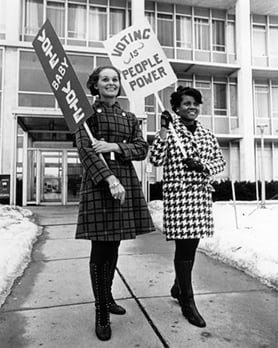League of Women Voters of Buffalo
Niagara
Highlights from our History
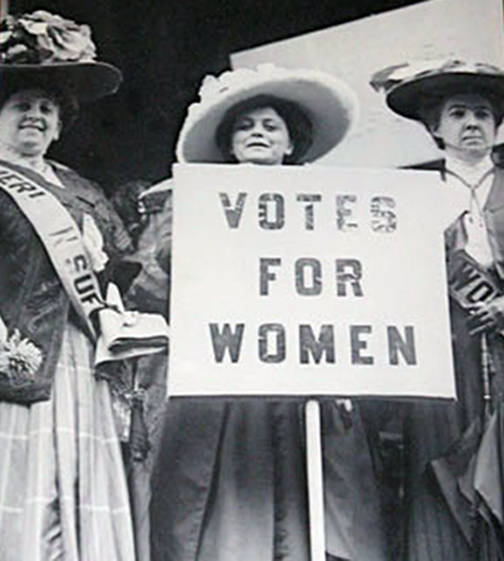
The Erie County League of Women Voters was christened at the May 27, 1919,
annual luncheon of the Erie County Women’s Suffrage Party according to an
article in the Buffalo Enquirer on May 28, 1919. Mrs. James Lee Laidlaw,
chairman of the League of Women Voters of New York State predicted that the
National Women’s Suffrage Association would merge into the League of Women
Voters. Miss Elizabeth Olmstead, chairman of the Erie County League of Women
Voters, introduced the speakers at the luncheon at the Hotel Lafayette with
approximately 350 attendees.
THE ROARING TWENTIES
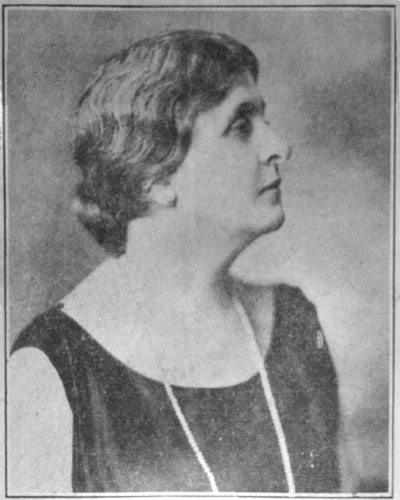
Mrs. John Hardie Peterson,
Erie County League President, 1927 - 1929
In 1921, the League began conducting citizenship courses at the Buffalo Seminary, a private high school for girls, and the YWCA.
In 1921, the East Aurora-Elma League was formed.
In the 1920s and 1930s, the Erie County and Niagara County Leagues were in the Eighth Region of the New York State League, which included 15 counties in Western New York. About 200 women attended the 1929 regional conference held in Perry, New York.
In April 1924, the National League of Women Voters held its convention in Buffalo. Carrie Chapman Catt was a featured speaker.
From 1926 through 1939, the Erie County LWV conducted political institutes in conjunction with the University of Buffalo. The proceedings featured forums and round table discussions on issues of the day. Many of the institutes were three days long.
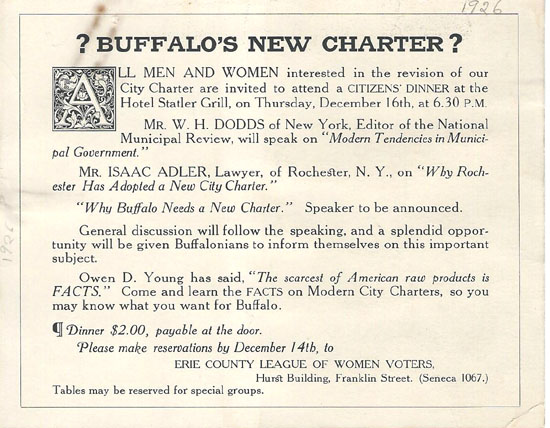
This 1926 flyer is from the Erie County League of Women Voters
In 1927, the League hosted many porch meetings at houses of League members to discuss the proposed New City Charter of Buffalo and a series of Thursday evening meetings to educate women on the many angles of the issue prior to voting it. Voters approved the new charter on August 29, 1927.
In 1926 to 1927, the Amherst LWV was formed. The board met for the first time on June 3. Throughout its history, the Amherst League actively monitored the Amherst Town Board. In 1927, three members spent three days copying the addresses of 2500 women voters in Amherst and mailed letters to each of them urging them to vote in election primaries. “As a result of this effort, primary voting rose from less than 20 persons who had voted in any primary to 832 in the Republican primary alone.” Source: 75 Years of a Great Idea published by The League of Women Voters of New York State.
The 1928 LWV New York State convention was held in Buffalo.
THE YEARS OF THE GREAT DEPRESSION
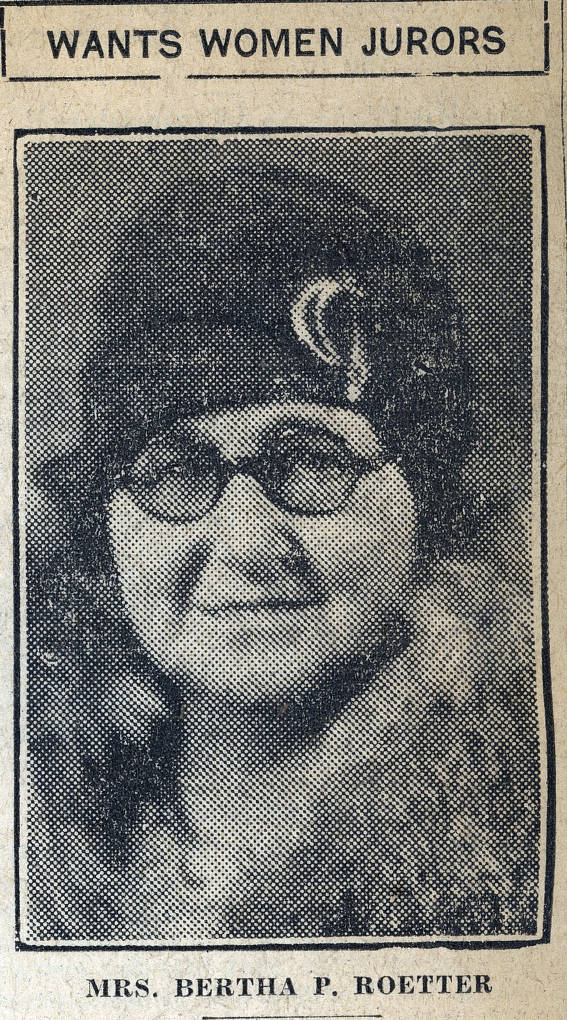
What Mrs. Bertha P Roetter wants,
Mrs. Bertha P Roetter gets!
In 1930, members of the Erie County League collected 3,000 signatures on a petition supporting the Women Juror Bill, which would permit women in New York to serve on juries. The law was passed on September 1, 1937.
The Erie County League hosted a radio program series on political affairs in the 1930s.
The Hamburg LWV began in 1936. The members participated in all local, state and national studies, candidate forums and voter registration drives.
The Springville LWV was accepted as a special group in 1936. The suburban Leagues were called branches in the minutes of the Erie County League. The Tonawanda LWV started in 1939. In 1939-1941, board meeting minutes were headed Buffalo & Erie County LWV.
THE WAR YEARS
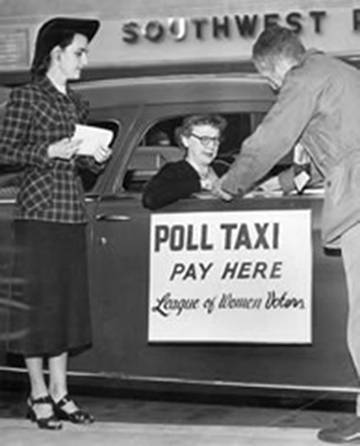
In April of 1941, the League reorganized with an Erie County Council composed of all the branches and the Buffalo City League with its office. In 1947, the Buffalo League was renamed the Buffalo Metro LWV.
During the 1940s, League members “served on community agency boards ... successfully supported the placement of all libraries under county control, worked for continuance of day nurseries for the convenience of war mothers, pushed juvenile protection and household employment standards.” [1]
POST WAR PROGRESS
The Clarence LWV began in 1952.
Local efforts in the 1950s included working for “adequate money for Buffalo school budgets, opposition to removal of restrictions on the succession of the incumbent mayor and councilmen, increased Buffalo parks area, an opposition to appropriation of park lands without replacement of equivalent acreage.” [1]
The League continued its work for an executive type county charter.

In 1952, seven Leagues in Erie County adopted a study of the present county government and possibilities. In 1956, the Leagues promoted reorganization of Erie County government with a strong executive form of government.
The local Leagues worked tirelessly for Permanent Personal Registration (PPR) for voters beginning in the late 1940s. “Among other efforts, members painted yellow footsteps throughout downtown Buffalo, leading to the Board of Elections. The paint was supposed to wash away, but because the paint provider accidently provided indelible paint, the footsteps lasted for years. Restaurants served a special PPR sandwich of pastrami, pickle and rye on placemats that explained permanent personal registration.” [2] In 1957, PPR was achieved!
THE 60'S AND 70'S
From 1960 through 1967, the League supported the Erie County Charter that provided for a strong executive and a County Legislature composed of single member districts apportioned equally according to population. “The League’s influence in gaining the charter in 1959 for Erie County is now part of a legend. Hats, bands, buttons, a quarter million handbills, two telephones and the reams of print” all were used to educate and convince voters to support the charter. Then the League worked to reapportion the Board of Supervisors; that effort was accomplished in 1967 with voter approval of the “County Legislature composed of single member districts apportioned equally according to population.” [2]
In 1963, the Erie County Council became a coordinating unit for county wide issues and program and worked solely on issues related to county government. An ILO replaced it in 1972 for ten years. The ILO disbanded in 1982 because declining membership made it difficult to staff local boards and the ILO Board. League structure through local Leagues was retained.
From 1965 to 1971, the League “promoted the establishment of a District Court in Erie County.”
The League of Women Voters of Kenmore, Inc., was incorporated by the State of New York on October 26, 1967, as a 501(c)(4) not for profit. During its active tenure, the Kenmore League included Tonawanda and Grand Island. At one point, the Grand Island League became a unit of the Kenmore League.
A study to support a comprehensive public transportation system in Erie County concluded with consensus in May 1974. The position states in part, “The League envisions an integrated transportation system that will offer mobility for all people, protect the environment, conserve energy, promote efficient land use and improve the economy of the Buffalo central business district.” (No footnote needed)
The Orchard Park League began in 1977.
THE END OF THE 20TH CENTURY
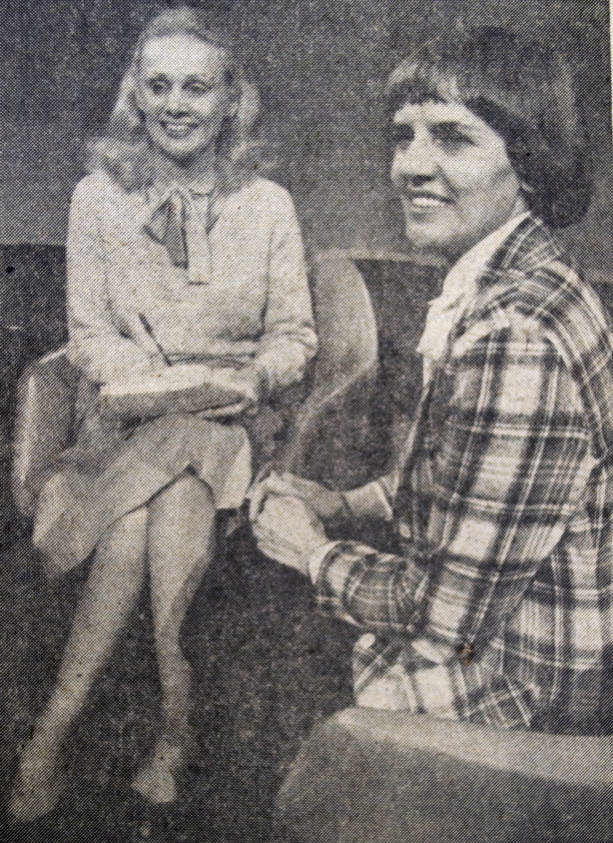
Photo of the two hosts in the studio
From 1981 to 1989, the League produced a weekly TV interview program, In League with You. Gloria Aquila and Marian Deutschman hosted it.
The West Valley Demonstration Project began with the West Valley Demonstration Project Act of 1980. The act requires that the Department of Energy is responsible for solidifying the high-level waste, disposing of waste created by the solidification, and decommissioning the facilities used in the process. The radioactive waste at West Valley in southwest New York State endangers the water supply for Western New York if it is not disposed of correctly. For most of its existence, the League has had a seat at the table of the West Valley Citizen Task Force and Lee Lambert occupied that seat.
In the early 1990s, the six Leagues in Western New York, Amherst, Aurora-Elma, Buffalo Metro, Clarence, Hamburg and Orchard Park decided that a merger would address declining membership and the difficulty of coordinating six individual Leagues to address county issues. On May 24, 1995, the League of Women Voters of the Greater Buffalo Area held its organizational meeting and elected its first board of directors. The six Leagues continued to conduct program in their communities as units of the new League. One by one, the units ceased their efforts until, in 2016, the last remaining unit in Amherst stopped its work in Amherst. Today, all efforts are conducted by the work of members from all the communities in its jurisdiction.
After a study of waterfront development, League members reached consensus and adopted a Position on Waterfront Development in Erie County on November 4, 1996. In 2018, the League and partner organizations are engaged in efforts to guarantee that development of the Outer Harbor on Lake Erie’s eastern terminus is developed in concert with that position.
The League began conducting tenant council and resident commissioner elections through contracts with the Buffalo Municipal Housing Authority in the 1990s.
THE 21ST CENTURY
This League incorporated as the League of Women Voters of Buffalo/Niagara (LWVBN) through its initial filing with New York State on November 22, 2002, as a 501(c)(4) not for profit. Prior to that date, the Greater Buffalo League worked informally with members from Niagara Falls. The incorporation officially added Niagara County to the local League jurisdiction.

Period web banner from the campaign
In 1998, Katherine “Taffy” Tarbell (1921-2007), chair of the Local Government Committee of the LWVBN, had the vision to see that there was a need to curb urban sprawl and to develop regional planning in Erie and Niagara Counties. She gathered materials to produce a state concurrence on urban sprawl that was announced by the State Board in spring 2000.
Meanwhile, she was applying for grants to support an education campaign on urban sprawl. In 1999 and 2000, she obtained grants totaling $107,545 to fund this project, and she became the project director. She and her committee spent months working on renting an office, hiring a part-time staff member, developing a presentation, purchasing equipment, and training members to deliver our PowerPoint presentation.
In June of 2000 the committee launched The Sprawl Campaign to educate citizens about the economic, environmental, and social costs of sprawl, on remedies being used in other urban metropolitan regions around the country, and about options available to this region to reverse the trend. Sixteen LWVBN members took the presentation to luncheon groups, church groups, classrooms, citizens' groups, government groups and any gathering that would hear them, reaching many hundreds of citizens with our message.
For this effort, they won the awards listed below:
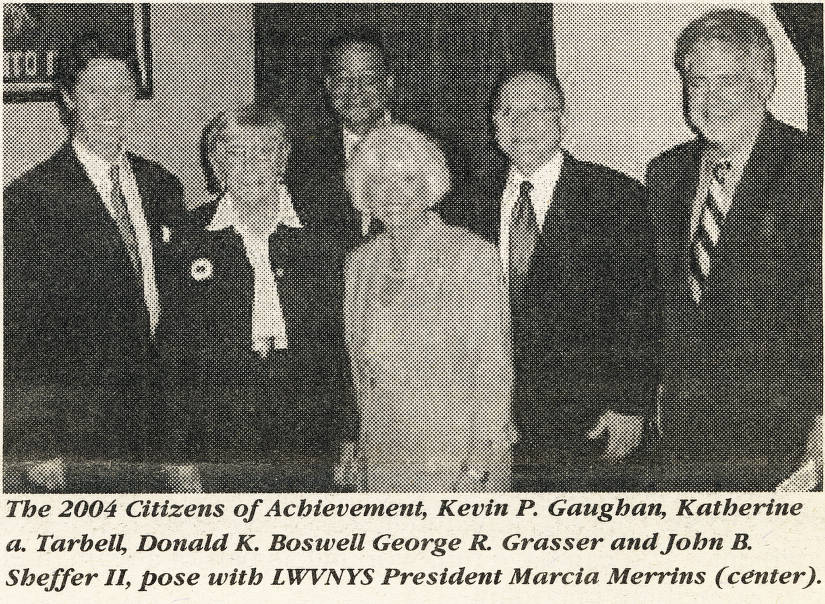
Taffy Tarball pictured here left of center
- Civic Empowerment Award from the Buffalo Niagara All-America City Committee, April 2002.
- Public Education Award from the Western New York Section of the American Planning Association, June 2002.
- 2002 Outstanding Planning Project in Public Education from the American Planning Association New York Upstate Chapter, September 2002.
- 2003 Public Education Award from the national American Planning Association, announced in November 2002.
It took some time for the lessons of the campaign to influence the attitudes of local leaders, but current leaders generally accept and act on the message the campaign delivered.
LWVBN undertook a study related to merging local governments in the early 2000s. The resulting consensus was the establishment of criteria for support of intergovernmental relationships. It was approved in June 2008 and became the model for the position adopted by the League of Women Voters of New York State (LWVNYS).
During the early years of this century, LWVBN undertook four studies related to alternative sentencing and re-entry that followed the positions established by LWVNYS. The Re-Entry Committee hosted full day conferences in 2008 and 2009: Alternative Sentencing and Re-Entry in Erie County and Re-Entry Support in Western New York.
On January 31, 2009, LWVBN members participated in a Climate Change Café to craft a low carbon diet to decrease energy consumption of participants. LWVNYS recognized the effort with an award for “Thinking outside the box.”
Throughout their history, the Leagues in Erie and Niagara Counties worked and continue to work tirelessly on state and national League studies, lobbying state legislators each spring, producing publications such as an annual Voters Guide and information about individual communities and elected officials at all levels of government and conducting voter registration drives and candidate forums. Program events about topical issues are planned and carried out monthly from September to June each year. Members speak and register new voters at naturalization ceremonies in Buffalo, currently 35 ceremonies each year.
Prepared by Terri Parks with the invaluable assistance in research by the Women’s Suffrage Celebration Committee. Ann Huberman provided the comments about the Sprawl Campaign.
Updated February 2019
Endnotes:
1. Ellen Taussig, “Women Voters’ Diary -- 40 Years of Achievement,” Buffalo
Evening News Magazine, August 20, 1960
return to text
2. Some History of Erie County Council LWV or The way we were since ‘52
return to text
Photo credits:
3. Political cartoon of League woman campaigning for Permanent Personal Registration (PPR) is from the League of Women Voters of Amherst collection at the Buffalo Niagara Heritage Village, via New York Heritage digital collections
4. All other illustrations come from the League of Women Voters of Buffalo Niagara Collection at the University at Buffalo Libraries - Digital Collections, via New York Heritage digital collections
[ Top ]


